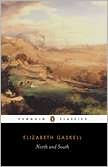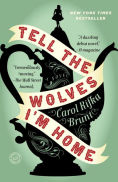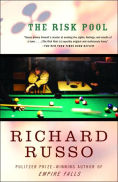This 1855 novel has much to say about our own times. It is the story of eighteen-year-old Margaret Hale who moves with her parents from a rural hamlet in the south of England to the fictional Milton in the industrial north. There is a bit of misdirection at the beginning of the story, which starts in London where Margaret has been living with her aunt, uncle and cousin Eliza for half of her lifetime.
The story then moves to Margaret’s beloved Helstone, where she has returned to live with her parents after Eliza’s wedding. She says Helstone is “‘only a hamlet; I don’t think I could call it a village at all. There is the church and a few houses near it on the green—cottages, rather—with roses growing all over them.’” While there, she awkwardly receives a proposal from the brother of Eliza’s new husband.
So far it seems like a romance, a novel of manners. But then Margaret’s father suffers a crisis of conscience, gives up the church, and moves the family north where he will become a private tutor.
Similar to the U.S., with its tensions between red and blue states, coasts and midlands, the U.K. has traditionally been divided between the industrial north and the agricultural south. These tensions drive the story. Set in the early days of the Industrial Revolution, Gaskell uses Margaret’s mistakes and misunderstandings to explore issues related to the first-generation cotton mills and those who own or work in them.
When the Hales first arrive in Milton, they detest the noise and hurry and dirt. Margaret takes a dislike to her first acquaintance, John Thornton, brusque owner of Marlborough Mill and her father’s first pupil. She looks down on him as a tradesman, “sagacious, and strong” but “not quite a gentleman”. She criticises him, too, for not caring for his workers outside of work hours, saying he should be giving them moral instruction and making sure they have enough food and a decent place to live. But that is not how things are done in the north, where workers are free to make their own choices once they leave work.
Margaret quickly befriends a young woman, Bessy Higgins, whose father John works in another mill. Horrified by their poverty and Bessy’s “cotton consumption”, a disease caused by the air quality in the mills, Margaret invites herself to their home to bring a basket of food, as she used to do in the south for her father’s poorer parishioners. To her surprise, the Higginses are offended. As she learns to respect their independence, they become friends.
Margaret’s mistakes and missteps in what to her is an entirely new culture mirror our own easy assumptions from the beginning of the story: that a London wedding and an awkward proposal in a pastoral rose garden signalled a familiar story of romance. Gaskell’s clever misdirection resulted in my feeling great sympathy for Margaret as she struggles to to look past her preconceptions and recognise what is really there.
Margaret’s coming-of-age story alone is sturdy enough to carry the reader’s attention, but what I found intriguing were the even-handed discussions about the rights and responsibilities of “masters” and “men”. These organically arise in the story as Margaret’s reactions, conversations between her father and Thornton, Thornton and his fellow mill owners, and—most interestingly—between Thornton and Higgins, whom Margaret brings together.
Thornton complains that workers don’t understand the market forces that prevent him from raising their wage, while the workers believe he is just living in luxury while they suffer.
As Thornton and Higgins begin a strange sort of friendship, their mistrust and misunderstanding of each other fade and their respect grows. Thornton has already installed a wheel to draw out the cotton fluff that fills the air and destroys lungs, over the objections of some workers who believe all the fluff they swallow inadvertently helps prevent hunger. Thornton works with Higgins to provide a hot midday meal for the workers, so they at least get one good meal a day.
As workers, our concerns today are less about food and more about health care and other benefits, but the same mitigation holds true. In companies where owners and workers communicate, such as the one where I was lucky enough to work, benefits and the occasional necessary belt-tightening are out in the open.
The novel takes place during a time of great social upheaval. Industrialisation was changing the job market—Margaret’s mother can’t find a maid willing to work for a Helstone wage when young women could be earning more in a factory—at the same time that railroads were revolutionising movement. And everything was speeding up.
We are at a similar crossroads. Globalisation and automation are changing the face of work. Without unions—whose pros and cons are explored here too—workers are at the mercy of the bosses. With so many companies being publicly traded rather than owned by one person or one family, there is no Thornton to appeal to. Income inequality is even worse than during Gaskell’s time. And, yes, things seem to be speeding up even more.
One way to gain a more balanced view of the issues which divide us today is to look at how they played out in the past. This novel, sweetened as it is by Margaret’s story, is an excellent start.
Have you read a novel that’s helped you understand one of today’s issues?


